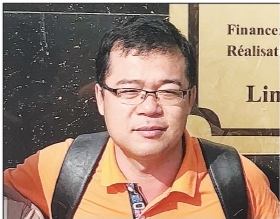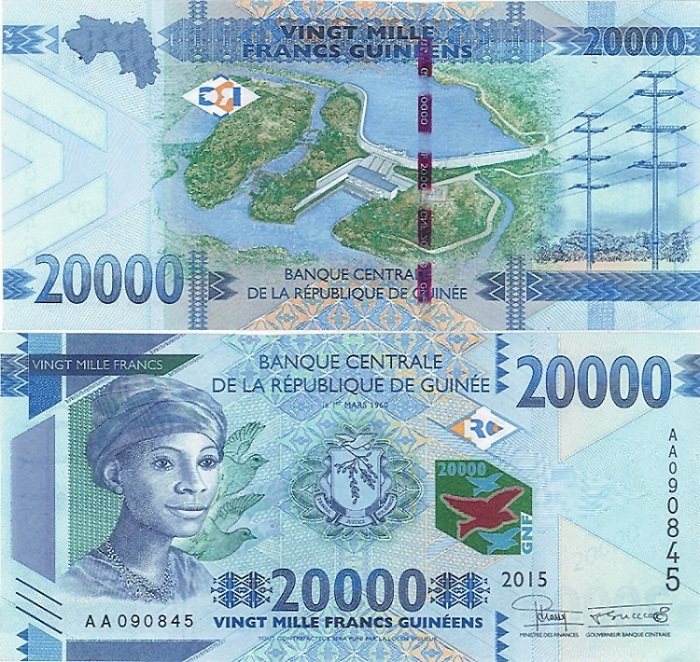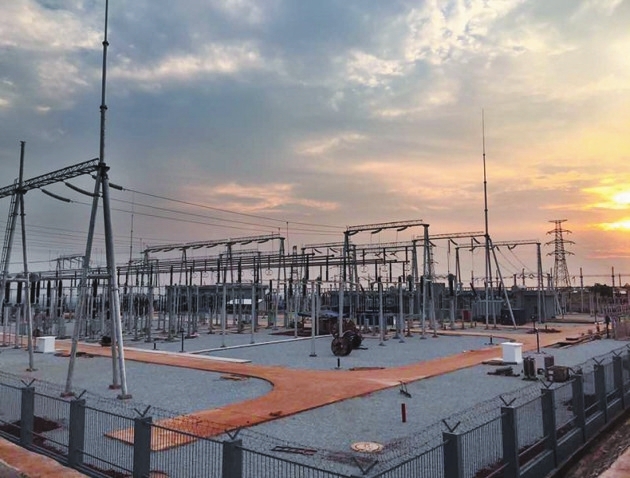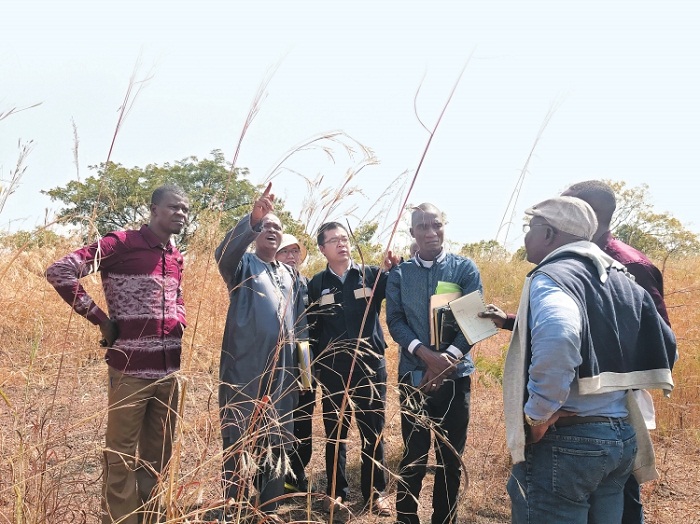from:China Southern Power Griddate:2019-07-05

Conakry, Guinea - You may not think from first glance but Xie Liujun is a very special man.
As the Chief Engineer of the Transmission Line Construction Department of the Guangxi Transmission & Substation Construction Company. Xie is a foundation builder of the Guinean power grid. During six years of hard work in a land very far from home.
Xie is a man without a county in a foreign land; but has still made outstanding achievements and accomplished his years-long mission to complete major projects between China and Guinea, such as the Kaléta Hydropower Station Project and the Conakry Electricity Network Rehabilitation and Extension Project.
To this date … his mission in Africa continues.

Guinean people commemorate “Chinese Projects” in a very special way. A sketch of the Kaléta Hydropower Station is printed on the back of the new 20,000 GNF banknote, the largest denomination in Guinea. The two base towers depicted on the banknote are the very ones designed and constructed by Xie.
Guinea is more than 18,000 kilometers distant from China - the long and very winding road between Xie’s workplace and his homeland.
Guinea, located on the west coast of West Africa, spans an area of more than 246,000 square kilometers. Walking throughout this vast land, Xie performs what many may think are the most ordinary duties: exploration, design and construction.
For the past six years, he has overcome inconceivable hardships without regret and complaint. This is because he fully dedicated to the construction of the Guinean power grid and his achievements are impossible to overlook.
As Chief Engineer of the Transmission Line Construction Department of the Guangxi Transmission & Substation Construction Company, Xie is one of the pioneer Chinese power builders going overseas and part of the first group of China Southern Power Grid members working in Africa.
Xie truly is a living, breathing example of the day-by-day building of the Belt and Road Initiative.
Connecting with Africa
Xie has deep connections with Africa.
As early as 1978, the Guangxi Transmission & Substation Construction assisted in building the Burundi Overseas Project as an effort to “go global”. It has been 41 years since then and as China and the many nations of Africa deepen their cooperation, Xie’s team once again set out for Africa back in 2011.
This time, Xie volunteered to be on this journey to Guinea.
Guinea is on the list of least developed countries announced by the United Nations.
“At that time there was only one Chinese supermarket in Conakry. Once we heard about when goods would arrive, we waited at the gate of the supermarket in advance,” said Xie.
No doubt it was Year 2013 that was one of the happiest for Xie, who was the design manager of Guinea Conakry City Power Grid Construction Project, for he was able to eat “instant” noodles.
That were made in China!
Besides adapting to the different cultural traits of drinking and eating, it never occurred to him that the most challenging aspect of living so far away from China was his own “crisis of confidence”.
“Since there was not a unified standard for power projects, many times we would have heated debated with our Guinean colleagues on even the smallest technical problems,” said Xie.
Due to unfamiliarity of local business practices, the French consulting company hired by the Guinean owner, challenged Xie and his team members on many occasions and often raised doubts about the technologies that the Chinese experts from China Southern Power Grid brought with them to Africa.
During these many months, Xie referred his African partners to the international technical specifications, compared them with Chinese standards and expounded and proved that the techniques, presented by China Southern Power Grid, were proper and correct.
With all his calculations and technical references, Xie was meticulous in his discussions with the consulting company about every technical issue.
Moreover, Xie consistently surveyed the work being done each day and drew design sketches in the evening. Pushing himself around the clock, Xie worked himself into a frenzy, dropping 10 kilograms but finished the sketches, and passed the examination of the French consulting company within three months.
The Kaléta Hydropower Station project is the largest hydropower construction project jointly developed by China and Guinea and its supporting transmission and substation project is the overseas project invested by Guangxi Transmission & Substation Construction Company with the most human and material resources.
Xie is one of the builders.
Africa is an amazing place that boasts distinct seasons and various landscapes.
You can see brown and yellow everywhere during the dry season while the African plains turn a luxuriant green during the monsoon season. It is the first choice for tourists, but it is totally different for Xie who trudges from his bed every morning, through and into the wee hours of the morning to create new electrical power designs.
He had to carry measuring equipment weighing nearly 10 kilograms throughout the day, so daily supplies (except for water) is a true challenge.
“The route and length of each survey are thoroughly planned. Complex situations often occurred in each survey, so it takes a long time to measure repetitively. When possible, I would eat Chinese compressed biscuits and drink spring water on the roadside. We rested once, at most, if the work schedule was tight,” said Xie.
Lush primeval forests can be found spread throughout Guinea. The country is home to a “kingdom” of wild animals, such as gorillas and deer that often appear along their planned routes and many rare woods are located around the towers.
“An African friend once asked me why we walk the same route so many times. I told him that because there was a tree more than 1,000 years old, we need to choose the best spot to build the tower to bypass this ancient wonder and preserve it forever.”
Xie also said that in order to protect the native ecological environment, his team directed the placement of 176 piles along a 400-kilometer-long route.
“Lucid waters and lush mountains are invaluable assets. This we never forget when we are building the power grid in Africa,” said Xie, adding, “in Guinea, every project we design and construct is an symbol of China, so we can never be careless; nor shall we let ourselves, our motherland, and African people down.”
In March 2015, the Kaléta Hydropower Station was placed into operation, tripling Guinea’s electrical generating capacity. Since then, Guinea has been self-sufficient in its power supply. Residents in the nation’s capital in Conakry can today enjoy stable power supplies for the first time in their lives.
This is a true positive example of the Belt and Road Initiative in action.
In the past, Guineans cooled themselves with electric fans; they often suffered from power outages that occurred all too frequently that prevented fans to watch a complete televised football match.
But today, with a steady and reliable power supply created from the joint commitment of many partners, including China Southern Power Grid, Guineans can now enjoy air-conditioned homes and businesses to drive off the blistering summer heat while enjoying every match of the 2018 FIFA Women’s World Cup.
To express their appreciation, Guinean people commemorate “Chinese Projects” in a special way. The sketch of Kaléta Hydropower Station is printed on the back of the new 20,000 GNF banknote, the largest denomination in Guinea. The two base towers printed on the banknote are the very ones designed and constructed by Xie.
The famous Chinese writer Sanmao once said: “Once you set foot on the land, you will love it to the bone.”
For Xie, Africa is so fascinating that it makes him reluctant to leave.
“Guinean people are so hospitable. All the children in the village come and welcomed us. There are moving stories about the legendary guardians in this place,” said Xie who recorded the beautiful exotic landscapes and interesting experiences in Guinea for his social media pages in China.
For him, Guinea is not only a place to work but a second place he can call home.

In April 2015, a transformer substation designed by Xie - the Guinea 225-kV Manéah Transformer Substation - was placed into operation which further improves the power supply for production and life in Conakry, the capital of Guinea, and its surrounding region.
Confronting Ebola
Vast prairies, the massive migration of wildlife, poverty, underdevelopment and primitive worlds … these might be the first things that come to one’s mind when Xie speak of Africa.
During these past six years in Africa, Xie has been confronted with danger many times. But for him, the most unforgettable memory is about his confrontation with Ebola which causes a severe and often fatal hemorrhagic fever.
In 2014, Ebola broke out in West Africa, and the name Ebola gradually became synonymous for death. The capital city of Conakry was one of the most severely affected areas, where many construction teams from other countries simply withdrew their senior staff and left.
Unfortunately, the Ebola outbreak came during the most critical period for the Kaléta Hydropower Station Project and the Conakry Electricity Network Rehabilitation and Extension Project.
Any mention of the word “Ebola” would make even the most hearty Guinean turn pale.
“Ebola is mainly spread through body fluids and blood. During that time, in local clinics, medicines were thrown to the patients instead of being given out by hands, as everyone was trying to avoid any direct body contact,” said Xu Liang, General Manager of the project and Xie’s colleague in the area.
Xu recalled the days when slogans and informational posters about Ebola were frequently seen on the walls in the city streets. One of the posters, there was one popular line that read, “Ebola’s Real!”
He added, “the project was coming to a close when Ebola was raging. No one could deny one their urge to go home. We encountered so many hardships and twists and turns in this project, but as I see the engineering drawings become reality, I think it has been worth it.”
The picture that Xie posted on his social media page on March 29, 2015, illustrates his unease. Back then, as the rainy season was coming and as the workload of the project began to scale down, Xie planned to take some days off and go back to China to be reunited with his family that he hadn’t seen for more than one year.
But just a week before his departure, probably due to overwork, Xie was nearly bedridden with a low-grade fever.
"At the very beginning, I didn't worry too much about it. I took some Ban Lan Gen, a common traditional medicine in China for treating colds and fever and I felt better.”
But a week after his returning to China, Xie’s fever lingered and he realized the situation was worse than he had thought.
"Ebola outbreaks, hemorrhagic fever, those words flashed into my mind and I felt a sudden chill,” said Xie who to this day still has chilling flashbacks of that experience.
He was diagnosed by the local CDC as a potential carrier of Ebola virus and was sent to the ICU ward in a local hospital for isolation treatment.
Xie said it was the worries and calls of support and care from his family and colleagues that made him get through it.
"They would stay beside their telephone every night at 9:00 p.m., waiting for me to update them on my body temperature before they went to sleep. If I didn’t call them on time, even one minute late, or if my temperature was a little higher than the previous day, they would truly be on ‘pins and needles’.”
Fortunately, after one week of isolation, Xie was told that he was not infected with Ebola.
“It is only after I came to Africa that I knew I was so lucky to have such a strong family unit in China, united for my wellbeing. There is nothing more important than a harmonious and happy life in my homeland,” said Xie.
Riots and armed conflicts in Africa are no stranger to the team of China Southern Power Grid.
One evening in September, 2013, during the period of the Presidential Election in Guinea, Xie and a few of his CSG colleagues were trapped by rioting locals on their way back from the construction site.
Thugs were smashing and burning down homes, businesses and even toppling cars parked along the street. A group of thugs hurled sticks at the Chinese workers’ cars in an attempt to force them out.
To distract these roaming gangs, two cars packed with CSG staff took off in different directions and rushed to get out of harm’s way. One of the cars went into a nearby Chinese cement factory to take refuge and the other entered a deserted alley and circled back to the urban district.
By taking great care, the CSG staff were able to get themselves out of the riots.
Xie noted that the panic among the local populous that emerged from the riots totally paralyzed the capital city of Guinea and made him yearn for the value of life and liberty which are the afterglow of harmony and peace.
After the riots subsided, the CSG Project Department in Guinea strengthened its security measures, not only to arrange for local gendarmerie guards to be posted at the gate of the residences where the workers lived but also arranged for additional guards to be posted when the workers were out in the field.
It was also clearly stated that all China Southern Power Grid staff must return to their residences before dark and should not go out into the city at night unless absolutely necessary.
Xie has experienced much during his six-year stay in Africa.
Ebola, malaria, riots ... these challenges are not something familiar to men from China and embrace the saying, "if you survive a disaster, you will be blessed.”
Xie now carries these words with him wherever he travels in Africa.

In October 2018, Xie Liujun (center) and government officials of Mandiana Province, Guinea, were discussing about the power line route of a Linsan-Fomi-Kankan 225-kV project.
Four Decades of Friendship
During power grid construction, Xie completes many basic tasks, turning design drawings into real iron towers and power lines. This is also the most laborious work, for he has to work outside and, many times, in Africa’s most arduous weather conditions.
But his role is critical to the project and to the Belt and Road Initiative.
Over the years, his devotion to the construction of power grids has not been shaken by the challenges of wind, rain and heat. The sight of more households and places in Africa being lit by electric power pushes him harder to achieve his dreams.
In early 2018, the design and exploration for the 225 kV transmission lines entered a critical phase to connect power stations from the city of Linsan to Fomi and Kankan in Guinea.
During their exploratory mission, Xie mistakenly led the CSG team into an unknown hydropower station. As they walked around the station, they found at the corner a nameplate engraved with paragraphs of words in both Chinese and French.
Although some of the engraving words have been damaged, the words “built in 1972 with the assistance of the People's Republic of China" were visible.
“Chinois,Chinois,你好 (hello),你好!”
Team members suddenly heard a voice speaking in French, with a little Chinese “mixed” in. The voice came from a 64-year-old black man who was speaking out loud with some bananas and wild fruits in his hands. It turned out that the old man was a nearby resident and was involved in the construction of the hydropower station many years ago. He was only 18 years old back then, and he worked with the Chinese workers every day and regarded them as his brothers.
He later picked up some Chinese language.
Xie and his CSG colleagues were invited to the man’s house. To their surprise, the deep friendship that had been formed with his Chinese colleagues more than 40 years ago was still unforgettable to the old man.
In his house, the Guinean flag was hung together with the Chinese five-starred red flag. As he retold the old days when Chinese workers came to assist the construction of the hydropower station and the life he had lived with his Chinese brothers, the old man expressed his great gratitude to the Chinese team for delivering electricity to the nearby villages.
Hearing these passionate words, Xie was overwhelmed with a sense of responsibility. He thought, “although 40 years had passed, the locals still remembered the power station builders from China. Would they remember us and our work 40 years from now?”
The former principal of Julius Nyerere University of Kankan also remembered those old Chinese friends.
He said, “in the 1970s, the Chinese came to help with the infrastructure development in our country. Now that you are here again, I believe the power supply will be secured with your presence.”
The principal showed Xie’s team around the campus and classrooms, introducing in details the electricity consumption of the campus.
Friendship has also been built between Xie and the African people under the Belt and Road Initiative.
These many years has been witness to the spread of Sino-African friendship across the continent. In their spare time, Xie and his CSG colleagues often brought Chinese medicines to nearby schools.
The instruction of these medicines were carefully translated in French for the local children and their parents while Xie and the CSG staff also arranged some classes for local children and introduced to the students to stories of far away and wondrous China and about China Southern Power Grid.
"I will never forget the curiosity and thrill in their eyes,” said Xie.
Friendship between Africans and Chinese are being built one day at a time as homes and businesses are being lighted up wherever the Chinese team goes.
As China and Africa work together to build the Belt and Road, many Chinese workers, like Xie, have developed close friendship with the African people.
You Are The One I Care The Most
For a traveler far from home, Xie has his home deep in his heart.
“International business trips are big challenges for the workers. In fact, it is also a challenge for their family at home. The workers are away from their families, sometimes for several months, sometimes for a whole year. You can imagine the hard feelings when they are so far away to help with any daily problems at home,” said Meng Weiguo, Assistant General Manager of the Guangxi Transmission & Substation Construction Company.
To Xie, his life living in foreign nations for years far different from his colleagues. As a team leader, he is the one who has stayed in Guinea the longest time. Over the past six years, he has missed three opportunities to celebrate Chinese New Year with his family.
While he stayed in Guinea, busy in his work.
"Dad, come back and see what I’ve just learned.” This is what his children often spoke about during their many phone calls. Xie’s second child was born just as he had to leave China and board a plane to Guinea, so it was easy for him to count the years abroad.
“The years I spent abroad is the same as the age of my child,” said Xie.
The longer Xie stays abroad, the guiltier his feeling about leaving behind his wife and children.
"He is working his head off far from home, so we should do our best, too,” said Liang Bingbing, Xie’s wife.
Earlier this year, Xie came home from Africa and just found that his wife, who use to be dependent on him, now takes good care of the family.
He knew that there was a certain reason behind her change. What makes him most gratified, nevertheless, was the growth of his once “naughty” eldest son. As his father was always away from home, the boy took the paternal role in the family and even took part in the parent-child activities with his younger brother in kindergarten.
"January 2015, October 2017, February 2019," Liang recited the memory each time when Xie returned home.
“He’s been away from home for six years. I used to complain about it, but what he needs is unconditional support, so that’s what I’ve been trying to give him," said Liang who today takes care of all the family matters.
“Those who feel guilty for his family are the ones who has the strongest sense of responsibility, both for his family and for his work,” commented Meng, adding, “for every overseas project, Xie has always been the one that volunteered to participate and the last one left after the project completed.”
The challenges of working in Africa is far too easy for some staff to express but Xie has never shown regret.
Says Xie, “getting a project completed is like giving birth to a lovely baby. We’ve never given up no matter how hard it was. We believe that when a problem occurs, there will be a bunch of ways to solve it. As we see the drawings finally turn into real towers and power stations, we felt a great sense of fulfillment.”
Xie Liujun is a man with big dreams who can endure and overcome any adversity.
In Africa, there is a rare kind of wood named blackwood - Dalbergia Melanoxylon - which grows in a tropical rainforest.
There are unique features of this blackwood.
When it is cut, both its cross section and the longitudinal section show a beautiful texture but it is firm and solid, fireproof and endurable in water.
With such great vitality, it adapts to any harsh environment.
Like the blackwood. Xie Liujun is a tough, brave and persistent man.
Tel:+86-25-84152563
Fax:+86-25-52146294
Email:export@hbtianrui.com
Address:Head Office: No.8 Chuangye Avenue, Economic Development Zone, Tianmen City, Hubei Province, China (Zip Code: 431700) Nanjing Office: Building 23, Baijiahu Science and Technology Industrial Park, No.2 Qingshuiting West Road, Jiangning Economic Development Zone, Nanjing City, Jiangsu Province,China (Zip Code:211106)
